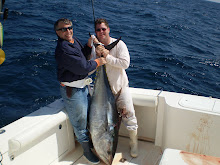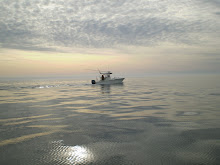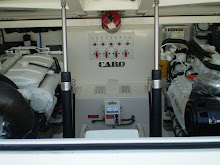 By Jim Field
By Jim FieldA regular feature of this blog will be the discussion of terminology specific to sportfishing. Like any other endeavor, fishing has its own library of specialized terms, some dating back to the beginnning of recorded history. On the contemporary front, our Crew regularly invents its own terms, which, if original and clever, enter permanently into our tribal language. Ideally, over time, if we hang together long enough, our wives won't have a clue what we're talking about. That's the plan.
To kick off our cataloge of terms, there's no better way to start than to tee up the dreaded "skunk." The skunk denotes a fishing trip that returns to the dock without catching a single fish, or for more demanding folks, the primary targeted fish of the day, e.g., you go out in search of marlin, and return with a sea robin, and for all intents and purposes,
you've been skunked.
All sportfishermen dread this calamity, and the shame it brings to each crew member--a stigma equivalent to what used to go with contracting leprosy. Getting the skunk can sometimes be no one's fault but the fish: they simply decided not to bite on the day you're able to go out and the weather cooperates. But leaving fish preferences and behaviors aside, the skunk also might suggest--absent objective evidence indicating otherwise, i.e., a fish!!--that the Crew is a bunch of losers. Masculinity is at the core of fishing psychology, and returning to shore with an empty fish box is the equivalent of castration and wearing high heels. We fished; we spent fuel money getting to the right water; we tried our best and applied all our skills--and we got
ZERO to show for it. It's an unbearable situation worthy of jumping over the side, or for real men, committing
sepuku (Japanese stomach-cutting ritual) in the cockpit, sitting with legs crossed, facing aft, looking at the jetting spray, with the sharpest bait knife onboard.

Because what happens, of course, is that you pull in empty handed and the boat next to you absolutely killed them--in fact, they limited out! Or, alternatively, the finicky fish were tough on every boat that day, but other guys nonetheless managed to catch one or two, and you got none, causing The Crew to ask "what the hell is wrong with us?" Perhaps it was the baits--the way they swam (hey, who rigged them?); perhaps the wrong choice of skirt colors; perhaps the speed at which we trolled--okay, perhaps the color of our damn shorts!
And what might be the exact origin of this term--the skunk? Well, we don't really know; this Crew hasn't researched it, to tell the truth. But we tie it to "stink," as in "you stink." That simple, that direct.
For a period after mooring, we do our work and suffer the humilation dearly, but then pull up, after a few necessary beers, to refocus on the next trip, and the need--the utter imperative--to catch fish in ample numbers, so as to "get the stink off the boat." In our deepest misery, when the skunk strikes us particulalry hard, we've also talked freely about taking a paint brush and painting the topside black, leaving a white line down the middle of the vessel. We're thinking: why not beat ourselves down completely, in the hope that the Fishing God might show us some mercy next time around? (That's us, always thinking ahead.)
So, in summary, the skunk is the
worst thing possible for fishermen--all fisherman, of every type. For us weekenders, its downright traumatizing, requiring one or two days sitting in meetings for a full recovery. Yet for charterboat captains, it's even worse--the ultimate walk of shame for those who earn their living on the sea. In reality, it doesn't happen all that often to them--these guys nearly always manage to pull a rabbit (i.e., quality fish) out of a hat. We weekenders, however, can't claim the same magic. Sometimes, God help us, we're just plain skunked, period--say no more. And, as for the final dose of humiliation, upon returning home what do we tell the wife and kids? Do they think we're losers too?























